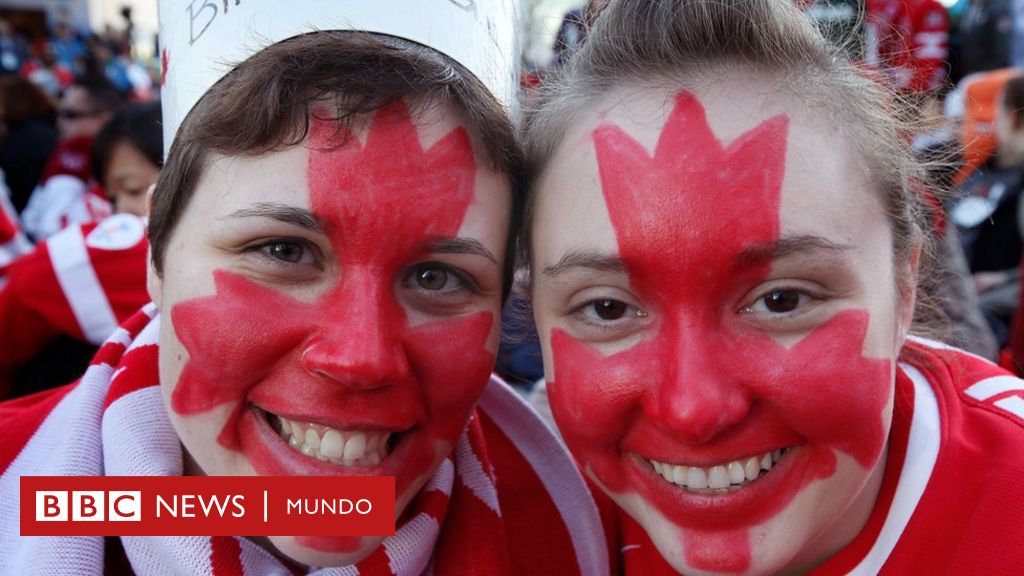- Pablo Esparza
- Special for BBC World
Image source, Getty Images
What does Canadian multiculturalism look like?
Canada made a pioneering decision in the world in 1971: the adoption of multiculturalism as a state policy. More than 45 years later, cultural diversity is one of the hallmarks of the North American country.
On October 8 of the same year, Pierre Trudeau, Prime Minister, announced to Parliament the establishment of this new political framework.
In 1973, Ottawa created the Ministry of Multiculturalism and, in 1988, this idea became a basic principle of the state through the Multiculturalism Act, which urges to interpret the Canadian constitution from this theoretical framework and to actively promote it.
Unlike states with multicultural or multinational policies, which try to articulate the different cultures of origin of the country, such as Bolivia, whose official name is the Plurinational State of Bolivia, Canadian multiculturalism focused from its origins on the integration of cultures brought by immigrants arriving in the country.
“Our roots extend to the four corners of the world. We come from far and wide and speak more than 200 languages. Our national fabric is dynamic and varied, woven by many cultures and heritages and underlined by the fundamental value of respect”, declared Canadian Prime Minister Justin Trudeau, son of Pierre Trudeau, on June 27, the day of multiculturalism in this country.
Image source, Getty Images
From its inception, Canada has had a dual French and British influence.
Today, at a time when xenophobic and anti-immigration rhetoric is on the increase in Europe and the United States, the Canadian is presented as an alternative – and long-standing – model which can turn out to be more and more exceptional. .
Corn, What does this concept mean? Why has Canada been a pioneer in its application? What is the assessment made of this policy 45 years after its implementation?
Like the rest of the American countries, today’s Canadian society is the result of the mixture of indigenous and colonial cultures and those brought by immigrants of other origins at different historical times.
However, unlike most American states, Canada is not occupied by a single “colonial power”: from its inception, the country had a dual French and British influence which marked the way the new state grew. is articulated.
“One of the reasons Canada is more receptive to multiculturalism than other societies is that it has never been culturally homogeneous.says Robert Wiseman, professor of political science at the University of Toronto.
“The Canadian state in 1867 was the product of modus vivendi which had been concluded between the English and the French, ”he told BBC Mundo.
Image source, Getty Images
“Canada has never been culturally homogeneous”, argue the specialists.
The “cultural accommodation” between these two communities, various of the English or French language and of the predominantly Protestant or Catholic religion, was joined by new immigrants, mostly from Eastern Europe and the United States. North, throughout the 19th and early 20th centuries.
Its role was decisive in the colonization of Western Canada. And when, in the 1960s, the question of identity began to be a topic of debate in the country, these groups claimed their place in Canada’s national narrative.
“They said that as Ukrainians or whatever their origin, they played a similar role in founding the country in western Canada as the French did in Quebec or the British in Ontario or in Atlantic Canada, ”he said. Andrew Griffith, former CEO of Citizenship and Multiculturalism Canada.
“The genesis of multicultural politics came, fundamentally, from groups that had been in Canada for a long time but, to be frank, were white and Christian,” Griffith told BBC Mundo.
Until 1962, the country had maintained racial requirements in its immigration policy, which favored immigrants of European origin.
However, the ethnic makeup of immigrant communities in Canada began to change from the 1960s and especially from the 1970s.
Image source, Getty Images
Canadian multiculturalism was based on the integration of cultures brought by immigrants arriving in the country.
By 1967, most of the new arrivals had already come from elsewhere, particularly from Asia and the Caribbean.
And this process transformed the idea of multiculturalism.
“It was a concept flexible and adaptable enough to offer the tools for integrating other groups quite easily, obviously not without a certain tension, when Canada opened up to immigration from other parts of the world,” explains Philips.
Another factor which, according to experts, has contributed to the adoption of a national multicultural policy has been the central government’s reaction to the rise of Quebec nationalism, which took off in the political arena of the predominantly French-speaking province in the 1960s.
“It was a time when the federal government was worried about the growing sense of independence in Quebec. A royal commission was therefore created to study bilingualism and biculturalism in Canada, ”said Irene Bloemraad, director of the Canadian studies program at the University of California at Berkeley.
“At the end of the process, it was announced that the federal government of Canada would have an official bilingualism policy and that this policy would be developed in the context of multiculturalism“he told BBC Mundo.
Image source, Getty Images
Pierre Trudeau, former Prime Minister of Canada, announced in 1971 that the country would implement multiculturalism as a state policy
In the early years, experts note, much of this policy was to promote and make visible the cultures of the different communities through events, language courses or funding for media in different languages.
Instead, over time, the issue of minority representation in institutions has grown in importance.
Currently, 20% of the Canadian population (according to data from the Organization for Economic Co-operation and Development, OECD, relating to 2013) he was born outside the country. Among the members of this body, only Luxembourg, Switzerland, New Zealand and Australia outperform the North American country in this index.
In Toronto, the largest city in the country, this proportion is close to 50%. In London and New York it is around 36%.
In 2015, according to official data, 41 of the 308 members of the Canadian Parliament were born outside the country.
On the same dates, according to the Pew Research Center, the United States Congress had six members of Congress born outside the United States.
Griffith describes the application of multiculturalism as a “big policy framework with small-scale measures”.
Image source, Getty Images
20% of the Canadian population was born outside the country.
“The American cliché is that it’s a melt in “ (a term that often refers to the “fusion” of cultures in American society): People are assimilated and become fully American. Even if the reality is more complex than that. The European attitude, time and again, has been to leave immigrants alone: as long as we don’t joke with them, they won’t bother us. It is not a true integration. The difference with the Canadian method is that it tries to avoid creating an opposition or a dichotomy“he says.
However, multiculturalism is also the target of criticism and Some argue that its application has had effects on the fragmentation of national identity and the acceptance of communities separated from one another.
“There are critics both on the right and on the left. On the right there are people who do not like multiculturalism because they believe that there should be a single language of cohesion and a more grounded citizenship. on similarity than on multiculturalism, “he emphasizes. Bloemraad.
“On the left, there are those who claim that multiculturalism is a way to divert attention from the deep problems of racism and inequality that persist in Canadian society,” adds the professor.
Image source, Getty Images
At the beginning of the 19th century, Canada offered employment opportunities and many immigrants, in this case Scots, embarked on the adventure.
Corn, Has this policy succeeded in making Canada an exception to the dissemination of xenophobic speech?
8 in 10 Canadians say immigration strengthens their country’s economy, according to a poll released in October 2016 and conducted by the Environics Institute, a Toronto-based sociological research firm.
In the United States, according to data published by the Pew Research Center in September 2015, this proportion reaches 51%.
In Germany it is 66%, 52% in the UK and 19% in countries like Italy and Greece.
“For far-right parties, it’s hard to attack multiculturalism or diversity because it’s like attacking Canada’s national identity. It’s very important. But it’s not the only one. reason, “says Bloemgaard.
“There is an electoral base which is immigrant. And the politicians are very careful not to leave their potential voters outside their speech,” he adds.
The immigration expert also cites the Canadian immigration system, which favors the arrival of trained immigrants, and the geographic location of Canada, whose only land border is with the United States.
Image source, Getty Images
The current Prime Minister of Canada, Justin Trudeau, son of Pierre, followed in his father’s footsteps to lead the country and pursue his multicultural policy.
“It keeps the country from having to deal with large refugee flows like Europe or large-scale immigration like the United States,” he says.
45 years after its implementation as a public policy, Multiculturalism is one of the characteristics Canadians frequently cite in polls when asked about what parts of their country are a source of pride for them.
In a way, experts say, multiculturalism has become part of the official history of Canadian identity.

“Evil alcohol lover. Twitter junkie. Future teen idol. Reader. Food aficionado. Introvert. Coffee evangelist. Typical bacon enthusiast.”
